-
ORIGINAL ARTICLE10-21-2022
“EMPODEREENF”: construction of an application for nurses’ continuing education on psychological violence against women
Revista Brasileira de Enfermagem. 2022;75(5):e20200391
Abstract
ORIGINAL ARTICLE“EMPODEREENF”: construction of an application for nurses’ continuing education on psychological violence against women
Revista Brasileira de Enfermagem. 2022;75(5):e20200391
DOI 10.1590/0034-7167-2020-0391
Views0See moreABSTRACT
Objective:
to construct a prototype of a mobile application on psychological violence against women to facilitate nurses’ continuing education.
Method:
an applied methodological research of technological development, based on the Contextualized Instructional Design method.
Results:
the prototype content was based on the learning objectives developed through a narrative review, which guided an integrative review to compile the information. The prototype is called “EmpodereEnf”, and is composed of an initial screen, bringing nurses as a target audience, and, soon after, offering nine general moblets for access to information such as: concepts, causes, manifestations and consequences of psychological violence; means for identification and approach in nursing consultation and health education; compulsory notification and referral; examples of cases of psychological violence and references.
Final considerations:
the prototype is a possibility for future coping interventions and a work tool for nurses in the face of psychological violence against women.

-
ORIGINAL ARTICLE10-21-2022
Management in the Family Health Strategy: workloads and structured institutional violence
Revista Brasileira de Enfermagem. 2022;75(3):e20220071
Abstract
ORIGINAL ARTICLEManagement in the Family Health Strategy: workloads and structured institutional violence
Revista Brasileira de Enfermagem. 2022;75(3):e20220071
DOI 10.1590/0034-7167-2022-0071
Views0See moreABSTRACT
Objectives:
to understand the relationship between workloads and institutional violence in Family Health Strategy managers’ practice.
Methods:
qualitative research using theoretical triangulation and data from semi-structured interviews. Participants were 35 managers of Basic Health Units in the five Regions of Brazil, who worked in the Family Health Strategy. We used thematic analysis and ATLAS.ti for data analysis.
Results:
workloads were analyzed, showing relationships with institutional violence. Thematic categories emerged: “related to the management work itself”; “related to other instances of health system management”; “related to users and community”. There was an interrelationship between increased managers’ workloads and institutional violence.
Final Considerations:
the Family Health Strategy is relevant for universal access to health and requires favorable institutional conditions for its effectiveness. Adverse scenarios lead to increased workloads, approaching institutional violence.
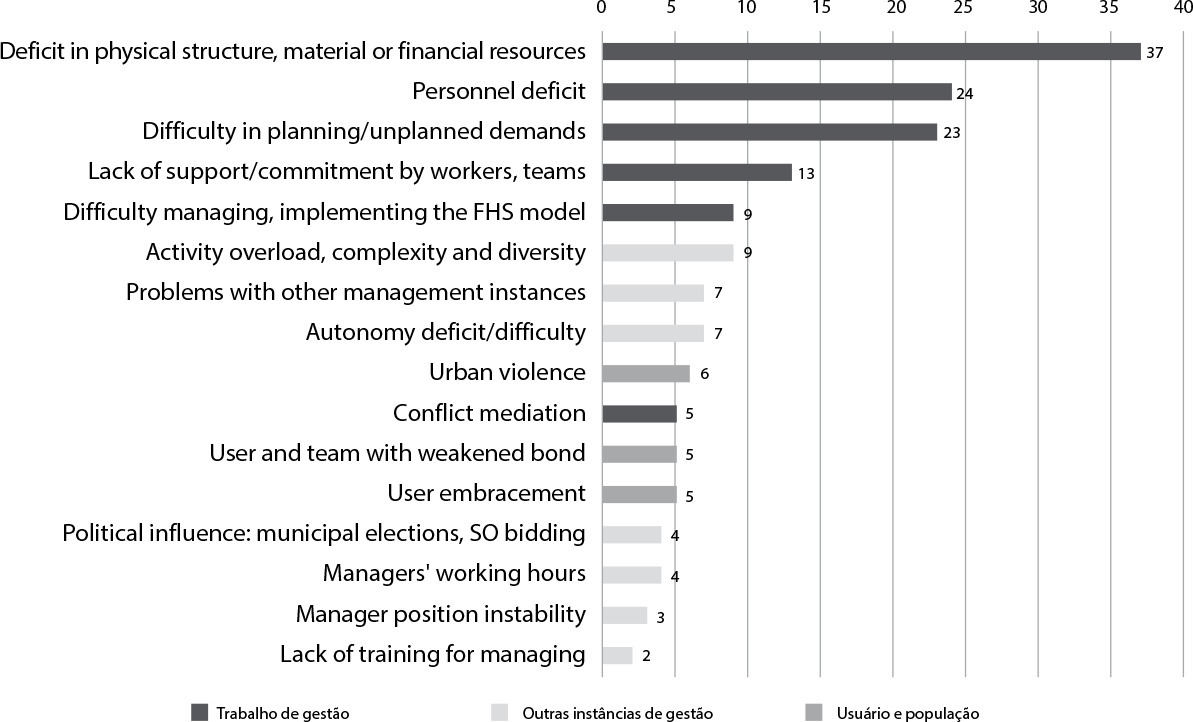
-
ORIGINAL ARTICLE10-21-2022
Self-care deficit among older men in the COVID-19 pandemic: implications for nursing
Revista Brasileira de Enfermagem. 2022;75:e20210933
Abstract
ORIGINAL ARTICLESelf-care deficit among older men in the COVID-19 pandemic: implications for nursing
Revista Brasileira de Enfermagem. 2022;75:e20210933
DOI 10.1590/0034-7167-2021-0933
Views0See moreABSTRACT
Objectives:
to analyze self-care deficit among older men in the COVID-19 pandemic in Brazil and to discuss the implications for nursing practice.
Methods:
web survey, multicentric, qualitative. A total of 120 older men participated, applying a form from April to June 2020 and April to August 2021. Reflective Thematic Analysis, interpreted by Orem’s Self-Care Deficit Theory, was used.
Results:
temporally, the self-care of older men was manifested in the self-care requirements – affective bonds, self-care for development – meditation and self-care with health deviations – remote consultations. Fully, partially compensatory, educational/support systems mobilized self-care.
Final Considerations:
as care managers, nurses can strengthen the support network for older men by activating professionals from the multidisciplinary team, family members, caregivers and the community to promote self-care and correct health deviations in times of crisis.

-
ORIGINAL ARTICLE10-21-2022
Circle dance: integrative and complementary practice in the daily health promotion for older adults
Revista Brasileira de Enfermagem. 2022;75:e20210003
Abstract
ORIGINAL ARTICLECircle dance: integrative and complementary practice in the daily health promotion for older adults
Revista Brasileira de Enfermagem. 2022;75:e20210003
DOI 10.1590/0034-7167-2021-0003
Views0See moreABSTRACT
Objectives:
to understand circle dance as an integrative and complementary practice for health promotion in older adults’ daily lives.
Methods:
an interpretive, qualitative study, based on Michel Maffesoli’s Comprehensive Sociology of Everyday Life. There were 20 participants, 17 older adults and three focalizers in circles held in Basic Health Units in a municipality in southern Brazil. Data were collected through interviews and observation, between September 2016 and March 2017, and analyzed through preliminary analysis, ordering, key links, coding and categorization.
Results:
three categories emerged that express the daily life of circle dance with older adults: circles that spin; challenges for new circles to spin; entering, being and staying in the circle.
Final Considerations:
circle dance provided older adults with a feeling of belonging to a group, combined with pleasure and well-being, contributing to promotion of older adults’ health.
-
ORIGINAL ARTICLE10-18-2022
Knowledge about antineoplastic drugs: implications for the health of nursing workers in a general hospital
Revista Brasileira de Enfermagem. 2022;75(3):e20210025
Abstract
ORIGINAL ARTICLEKnowledge about antineoplastic drugs: implications for the health of nursing workers in a general hospital
Revista Brasileira de Enfermagem. 2022;75(3):e20210025
DOI 10.1590/0034-7167-2021-0025
Views0See moreABSTRACT
Objectives:
to understand, from a worker’s health perspective, the knowledge of nursing professionals about the use of antineoplastic drugs in a general hospital.
Methods:
a descriptive and exploratory study with a qualitative approach. It was conducted at a university hospital, between April and August 2018, with 35 nursing professionals who responded to a semi-structured interview. Thematic analysis was used for data treatment.
Results:
from the data, three thematic categories emerged, related to the nursing professionals’ knowledge about antineoplastic drugs and their effects on workers’ health; situations in which exposure to these drugs occurs; and protection mechanisms for the patient, the environment, and the worker.
Final Considerations:
the nursing professionals had little knowledge about antineoplastic drugs. The practices related to handling and the necessary protective measures to deal with these drugs were empirically determined and relatively subsidized the knowledge acquired by the professionals.
-
ORIGINAL ARTICLE10-18-2022
Opinions of healthcare students on organ and tissue donation for transplantation
Revista Brasileira de Enfermagem. 2022;75(3):e20210001
Abstract
ORIGINAL ARTICLEOpinions of healthcare students on organ and tissue donation for transplantation
Revista Brasileira de Enfermagem. 2022;75(3):e20210001
DOI 10.1590/0034-7167-2021-0001
Views0See moreABSTRACT
Objectives:
to analyze the opinions of healthcare students on organ and tissue donation for transplantation.
Methods:
qualitative document analysis study, using the records of a database and analyzing data from two perspectives: 1) Lexical analysis, with the IRAMUTEQ software, and 2) Thematic content analysis.
Results:
from the analysis, 3 main categories were generated: 1) Organ and tissue donation as an act of love for others and an opportunity of a new beginning; 2) Clarification and awareness on organ and tissue donation; and 3) Importance of communicating the family and promoting organ and tissue donation.
Final Considerations:
despite being in favor of donation, students also recognize the presence of social taboos; the discussion in the family nucleus, promoting the theme and raising awareness in society are considered important. Additionally, the education of students is one of the possibilities of intervention for the issue.
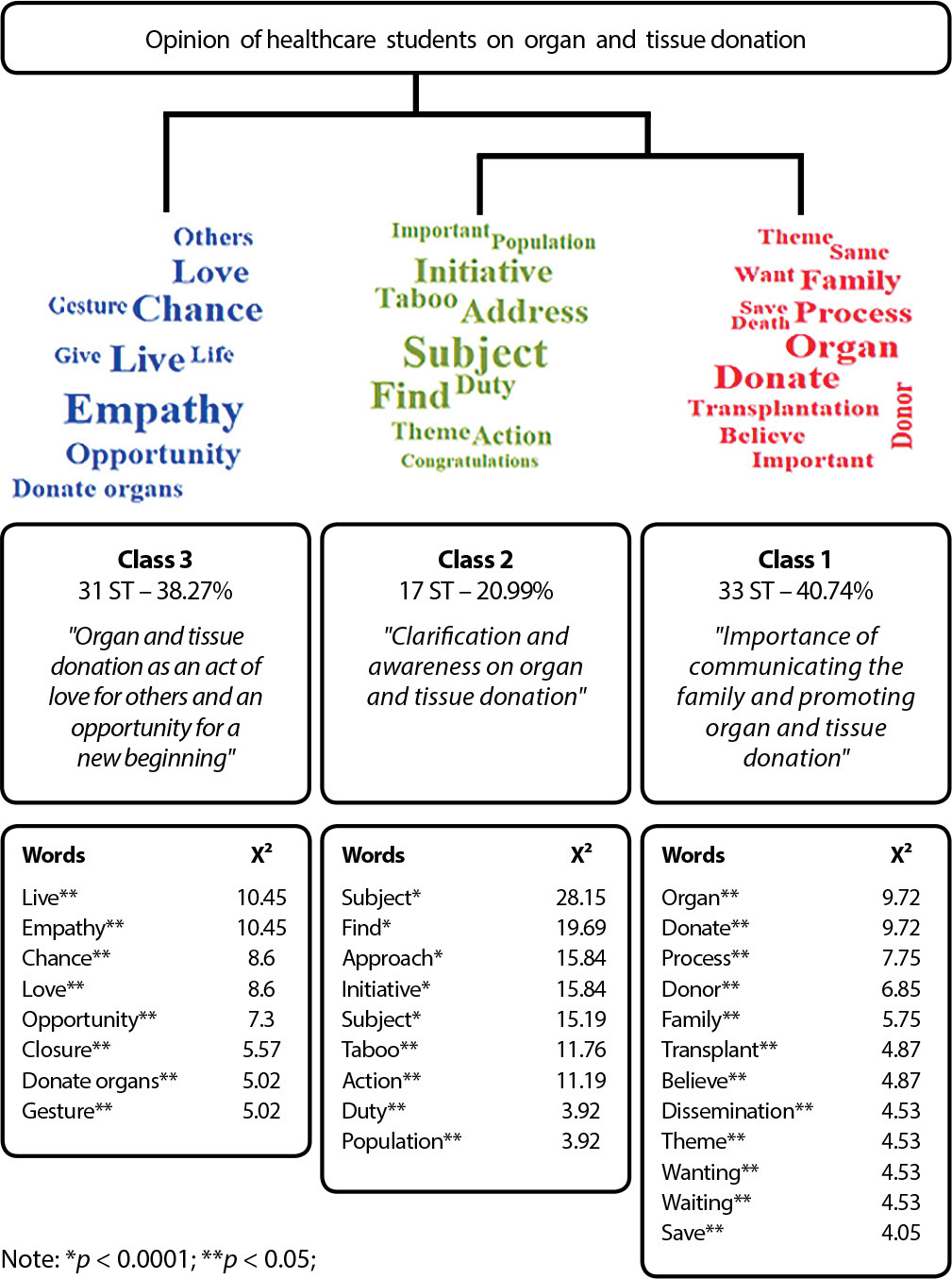
-
ORIGINAL ARTICLE10-18-2022
Being ethical and bioethical in daily life of primary health care: nurses’ perceptions
Revista Brasileira de Enfermagem. 2022;75(3):e20210093
Abstract
ORIGINAL ARTICLEBeing ethical and bioethical in daily life of primary health care: nurses’ perceptions
Revista Brasileira de Enfermagem. 2022;75(3):e20210093
DOI 10.1590/0034-7167-2021-0093
Views0See moreABSTRACT
Objectives:
to understand the perceptions of ethics and bioethics and how to be ethical and bioethical in daily life of Primary Health Care, from the perspective of nurses.
Methods:
this is a Holistic-qualitative Multiple Case Study, based on Comprehensive Everyday Sociology, with 54 participants.
Results:
two subcategories and the category Being ethical and bioethical in daily life of PHC: nurses’ perceptions emerged. The ethical and bioethical being permeates a subjective and abstract self, whose fears, anxieties and concerns are intertwined with the human and professional dimensions in daily work and in personal-professional relationship. Ethics and bioethics perceptions emerge from subjectivity, established relationships, lived experiences and daily actions of nurses essential to the profession, professionals and individuals to be cared for.
Final Considerations:
ethical and bioethical perceptions and attitudes are essential to care, management and organizational actions, health care, and the safety of users and professionals.
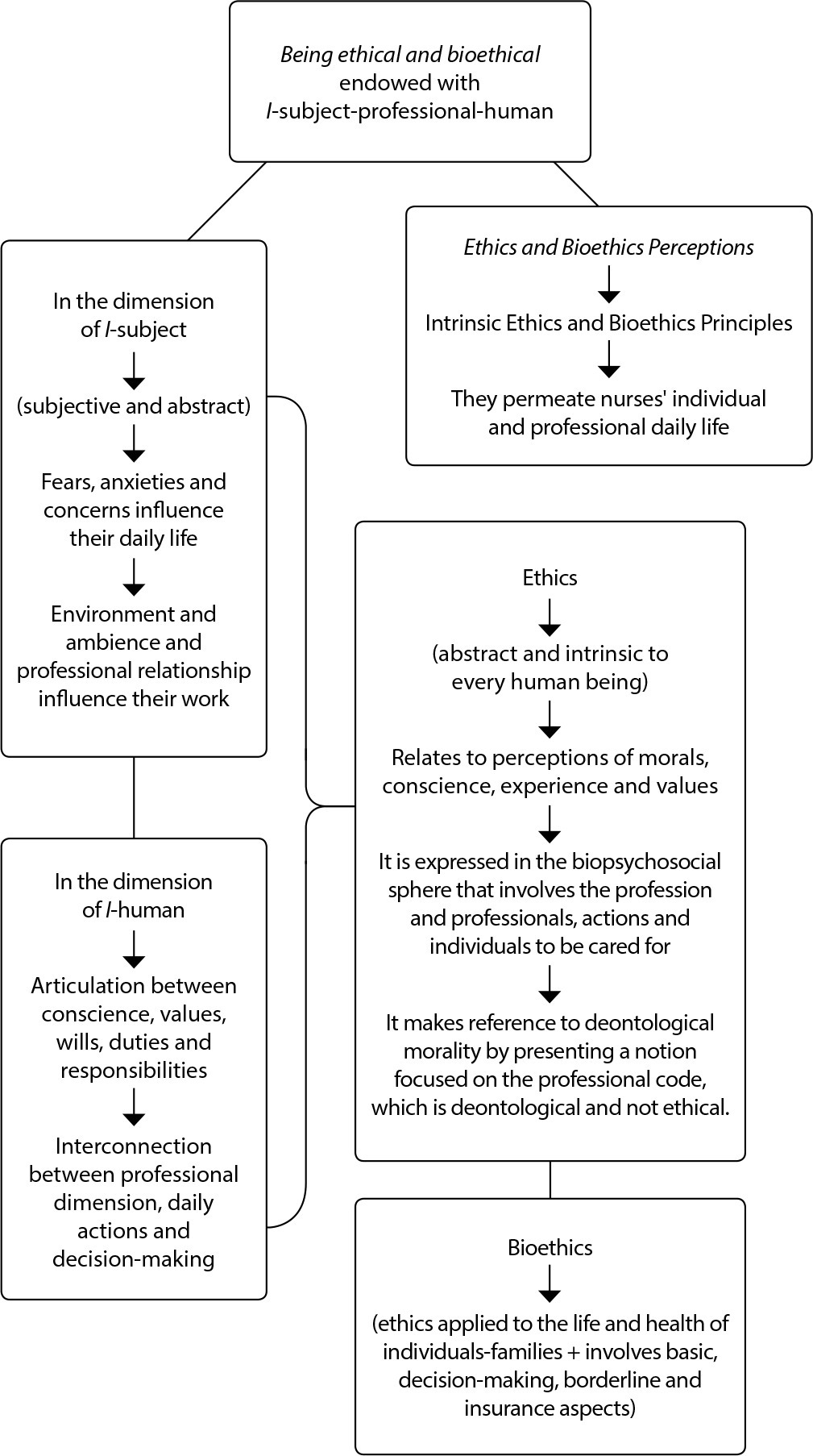
-
ORIGINAL ARTICLE10-18-2022
Breast cancer screening program for risk groups: facts and perspectives
Revista Brasileira de Enfermagem. 2022;75(3):e20210050
Abstract
ORIGINAL ARTICLEBreast cancer screening program for risk groups: facts and perspectives
Revista Brasileira de Enfermagem. 2022;75(3):e20210050
DOI 10.1590/0034-7167-2021-0050
Views0See moreABSTRACT
Objectives:
to measure the frequency and compliance of breast cancer screening, according to the risk for this disease.
Methods:
a cross-sectional study with 950 female users of 38 public Primary Health Care services in São Paulo, between October and December 2013. According to UHS criteria, participants were grouped into high risk and standard risk, and frequency, association (p≤0.05), and screening compliance were measured.
Results:
6.7% had high risk and 93.3% standard risk, respectively; in these groups, the frequency and compliance of clinical breast examination were 40.3% and 37.1%, and 43.5% and 43.0% (frequency p=0.631, compliance p=0.290). Mammograms were 67.7% and 35.5% for participants at high risk, and 57.4% and 25.4% for those at standard risk (frequency p=0.090, compliance p=0.000).
Conclusions:
in the groups, attendance and conformity of the clinical breast exam were similar; for mammography, it was higher in those at high risk, with assertiveness lower than the 70% set in UHS.
-
REVIEW06-10-2022
Self-inflicted violence and suicide in people living with HIV/AIDS: a systematic review
Revista Brasileira de Enfermagem. 2022;75:e20210768
Abstract
REVIEWSelf-inflicted violence and suicide in people living with HIV/AIDS: a systematic review
Revista Brasileira de Enfermagem. 2022;75:e20210768
DOI 10.1590/0034-7167-2021-0768
Views0See moreABSTRACT
Objectives:
to analyze intellectual productions on self-inflicted violence and suicide in people living with HIV/AIDS.
Methods:
a systematic review, carried out between March and April 2021, in the PubMed®/MEDLINE®, Web of Science and LILACS databases, subsidized in the Strengthening the Reporting of Observational Studies in Epidemiology. The period outlined was from 2011 to 2020.
Results:
a total of 199 studies were identified, and 16 composed the final sample, grouped into the categories: Sociodemographic characteristics of victims of self-inflicted violence/suicide and their intervening factors (pointing to young adults, especially homosexuals, with low social support and a history of mental illness or substance abuse as usual victims); Successful measures for suicide prevention/control in people living with HIV/AIDS (suggesting more frequent psychosocial and clinical follow-up of those starting antiretroviral and immunocompromised treatment).
Conclusions:
biopsychosocial follow-up, analysis of sociodemographic profile and intervening factors should be frequent in this population for disease prevention/control.

-
ORIGINAL ARTICLE09-05-2022
Screening for common mental disorder in elderly residents in the countryside: a cross-sectional study
Revista Brasileira de Enfermagem. 2022;75:e20210875
Abstract
ORIGINAL ARTICLEScreening for common mental disorder in elderly residents in the countryside: a cross-sectional study
Revista Brasileira de Enfermagem. 2022;75:e20210875
DOI 10.1590/0034-7167-2021-0875
Views0See moreABSTRACT
Objective:
To estimate the prevalence of common mental disorders and their associated factors in the elderly in a municipality in the countryside of the Brazilian Midwest.
Methods:
Quantitative, observational, cross-sectional approach research, conducted with 218 elderly people.
Results:
The prevalence of the common mental disorder among the elderly was 25.1%; in the univariate analysis, it was higher in females (35.4%), in the age group of 80 years or older (46.1%), brown skin color (30.2%), widowed (42.6%), illiterate (47.6%), and retired (27.6%). In the multiple analysis, the variables female gender (p<0.006), age 80 years or older (p<0.036), dissatisfaction with life (p<0.009), lack of social interaction (p=0.017), and dysfunctional family (p=0.021) remained associated with CMD.
Conclusion:
The results revealed are helpful and contribute to the reinforcement of the need for mental health care in this population extract so growing worldwide.
-
ORIGINAL ARTICLE06-03-2022
Association between falls in older adults and prevention group
Revista Brasileira de Enfermagem. 2022;75:e20200207
Abstract
ORIGINAL ARTICLEAssociation between falls in older adults and prevention group
Revista Brasileira de Enfermagem. 2022;75:e20200207
DOI 10.1590/0034-7167-2020-0207
Views0See moreABSTRACT
Objectives:
to assess the effectiveness of guidelines on fall prevention in a group of older adults in Primary Health Care.
Methods:
a cross-sectional study, carried out with older adults selected by a simple random sample (274; N=1,234). Data covered sociodemographic and socioeconomic variables, marital status, health conditions, factors associated with falls and participation in the prevention group. Student’s t test was used, and dichotomous variables were used by the chi-square test. The project met ethical requirements.
Results:
sample with female profile (61.7%), married, with low education, mean age of 71.69 years. The factors associated with falls identified were female sex, medicalization and participation in the prevention group. There was no protective association between participation in a fall prevention group in older adults and a decrease in the number of falls.
Conclusions:
based on evidence, a personalized intervention during the nursing visit is suggested as a strategy to prevent falls.

-
ORIGINAL ARTICLE03-07-2022
Predictors of frailty in older people users of Primary Health Care
Revista Brasileira de Enfermagem. 2022;75:e20201292
Abstract
ORIGINAL ARTICLEPredictors of frailty in older people users of Primary Health Care
Revista Brasileira de Enfermagem. 2022;75:e20201292
DOI 10.1590/0034-7167-2020-1292
Views0See moreABSTRACT
Objective:
to identify the prevalence and predictors of frailty in older people in Primary Health Care.
Method:
this is a descriptive and correlational study, carried out in a convenience sample of 136 older people in the community. Data were collected through a sociodemographic and clinical questionnaire and frailty phenotype. Student’s t test or U-Mann-Whitney test, chi-square and binary logistic regression were used for data analysis.
Results:
the prevalence of frailty was 26.5% (n=36). Frail individuals had older age (p=0.011), worse self-rated health (p=0.001) and lower physical capacity (p<0.001). In the multivariable regression, it was observed that frail individuals had older age (Odds Ratio=1.111; 95% confidence interval=1.026-1.203) and worse physical capacity (Odds Ratio=0.673; 95% confidence interval=0.508-0.893).
Conclusions:
the prevalence of frailty in older people in Primary Health Care was considerable. Advanced age and worse physical capacity were the most relevant predictors of frailty in the elderly.
-
ORIGINAL ARTICLE04-15-2022
Validation of Questionnaire to Assess the Impact of Dementia on the Family
Revista Brasileira de Enfermagem. 2022;75:e20210232
Abstract
ORIGINAL ARTICLEValidation of Questionnaire to Assess the Impact of Dementia on the Family
Revista Brasileira de Enfermagem. 2022;75:e20210232
DOI 10.1590/0034-7167-2021-0232
Views0See moreABSTRACT
Objective:
To validate a questionnaire to assess the impact of dementia on one of the household members.
Methods:
Methodological study. The instrument was designed based on literature review, expert opinion, and researchers’ experience and then applied to a non-probability convenience sample consisting of 262 family members who live daily with a person with dementia. The construct validity was studied by exploratory factor analysis, principal components method, with varimax rotation of the items.
Results:
An instrument with 30 items was obtained, distributed in four dimensions: “Emotional dimension,” “Economic dimension,” “Family relations dimension,” and “Support-seeking dimension.” Factor analysis revealed a total explained variance of 54.96% and a total Cronbach’s alpha of .899.
Conclusions:
The instrument presents high internal consistency, grouped into four dimensions, all closely related to the family’s adaptation to the onset of dementia in one of its members.
-
ORIGINAL ARTICLE03-07-2022
Is self-esteem associated with the elderly person’s quality of life?
Revista Brasileira de Enfermagem. 2022;75:e20210388
Abstract
ORIGINAL ARTICLEIs self-esteem associated with the elderly person’s quality of life?
Revista Brasileira de Enfermagem. 2022;75:e20210388
DOI 10.1590/0034-7167-2021-0388
Views0See moreABSTRACT
Objective:
To analyze the association between self-esteem and quality of life in the elderly.
Methods:
Cross-sectional web survey developed with 519 elderly people. Participants filled out three data collection instruments developed on the Google Forms platform and widely disseminated through all of Brazil. Fisher’s exact test, Mann-Whitney, Pearson correlation, and linear regression with 95% confidence interval were used.
Results:
Self-esteem was associated with all quality-of-life facets: sensory skills [β= 1.307; p<0.001]; autonomy [β= 2.101; p<0.001]; past, present, and future activities [β= 2.486; p<0.001]; social presence [β= 2.547; p<0.001]; death and dying [β= 2.175; p<0.001]; and intimacy [β=2.378; p<0.001].
Conclusion:
There is a positive and statistically significant association between self-esteem and quality of life in the elderly. We therefore suggest the development of local policies capable of raising this age groups’ self-esteem and reaffirming aging as a new possibility for discoveries and pleasure.
-
EXPERIENCE REPORT10-24-2022
Nursing process for elderly women susceptible to falls from the perspective of the Pender’s Model
Revista Brasileira de Enfermagem. 2022;75:e20210913
Abstract
EXPERIENCE REPORTNursing process for elderly women susceptible to falls from the perspective of the Pender’s Model
Revista Brasileira de Enfermagem. 2022;75:e20210913
DOI 10.1590/0034-7167-2021-0913
Views0See moreABSTRACT
Objectives:
to describe the strategy of applying the nursing process guided by Pender’s Health Promotion Model to elderly women susceptible to falls with a view to promoting a self-efficacy behavior for fall prevention.
Methods:
application of the nursing process to eleven elderly women who had already experienced falls, living in a neighborhood in the outskirts of Belem, state of Pará, which involved interviews to obtain their nursing history and group meetings using the focus group technique to develop the other phases of the nursing process: nursing diagnosis, nursing interventions, and nursing assessment.
Results:
despite the risk factors for falls, the intervention model adopted in this study allowed elderly women to enhance their self-efficacy.
Final Considerations:
the model proved to be suitable for the participation of elderly women in actions to build fall prevention behaviors, with a view to healthier lifestyles.

-
ORIGINAL ARTICLE10-24-2022
Factors associated with symptoms of physical and emotional burden in informal caregivers of the elderly
Revista Brasileira de Enfermagem. 2022;75:e20210927
Abstract
ORIGINAL ARTICLEFactors associated with symptoms of physical and emotional burden in informal caregivers of the elderly
Revista Brasileira de Enfermagem. 2022;75:e20210927
DOI 10.1590/0034-7167-2021-0927
Views1See moreABSTRACT
Objectives:
to analyze the personal and work-related burden factors associated with physical and emotional symptoms of informal caregivers of the elderly.
Methods:
cross-sectional study conducted with 121 informal caregivers and 121 seniors who received care, assessed individually for the risk of: physical overload, musculoskeletal symptoms, Self-Reporting Questionnaire, effort perception, and Katz index.
Results:
a greater perception of effort raises up to 3.3 times the chances of presenting symptoms of pain in the spine region (p=0.01), and lower functional capacity of the elderly increases up to 1.3 times the chances of presenting pain symptoms in the spine region (p=0.02). The symptoms of emotional overload were associated with the caregiver’s low income (p=0.02).
Conclusions:
the perception of effort, dependence of the elderly, caregiver’s age, and symptoms of emotional overload are involved with caregivers’ symptoms of physical overload, and low income, with emotional overload.
-
ORIGINAL ARTICLE10-28-2020
Conflict management strategies used by Portuguese nurse managers
Revista Brasileira de Enfermagem. 2020;73:e20190336
Abstract
ORIGINAL ARTICLEConflict management strategies used by Portuguese nurse managers
Revista Brasileira de Enfermagem. 2020;73:e20190336
DOI 10.1590/0034-7167-2019-0336
Views0See moreABSTRACT
Objectives:
to analyze the perception and conflict management strategies used by nurses in the management of people in Portuguese health services.
Methods:
descriptive, correlational study, carried out in Portuguese health services, with an intentional non-probabilistic sample, totaling 95 nurse managers. A questionnaire and Conflict Management Scale were used, analyzing the variables of managerial activities and conflict management, with the aid of software.
Results:
it was identified that 60% of the managers, report having to mediate conflicts daily, and the majority report adopting dialogue in conduct. However, through the Kruskal-Wallis test, it was shown that enforcement strategies in conflict management prevail (p = 0.008), with collaborative ones being more restricted to monthly intervals (p = 0.049).
Conclusions:
managers perceive the importance of collaboration in the mediation of conflicts, however, in their daily lives; they tend to maintain imposing behaviors, signaling for a little transformational leadership style.
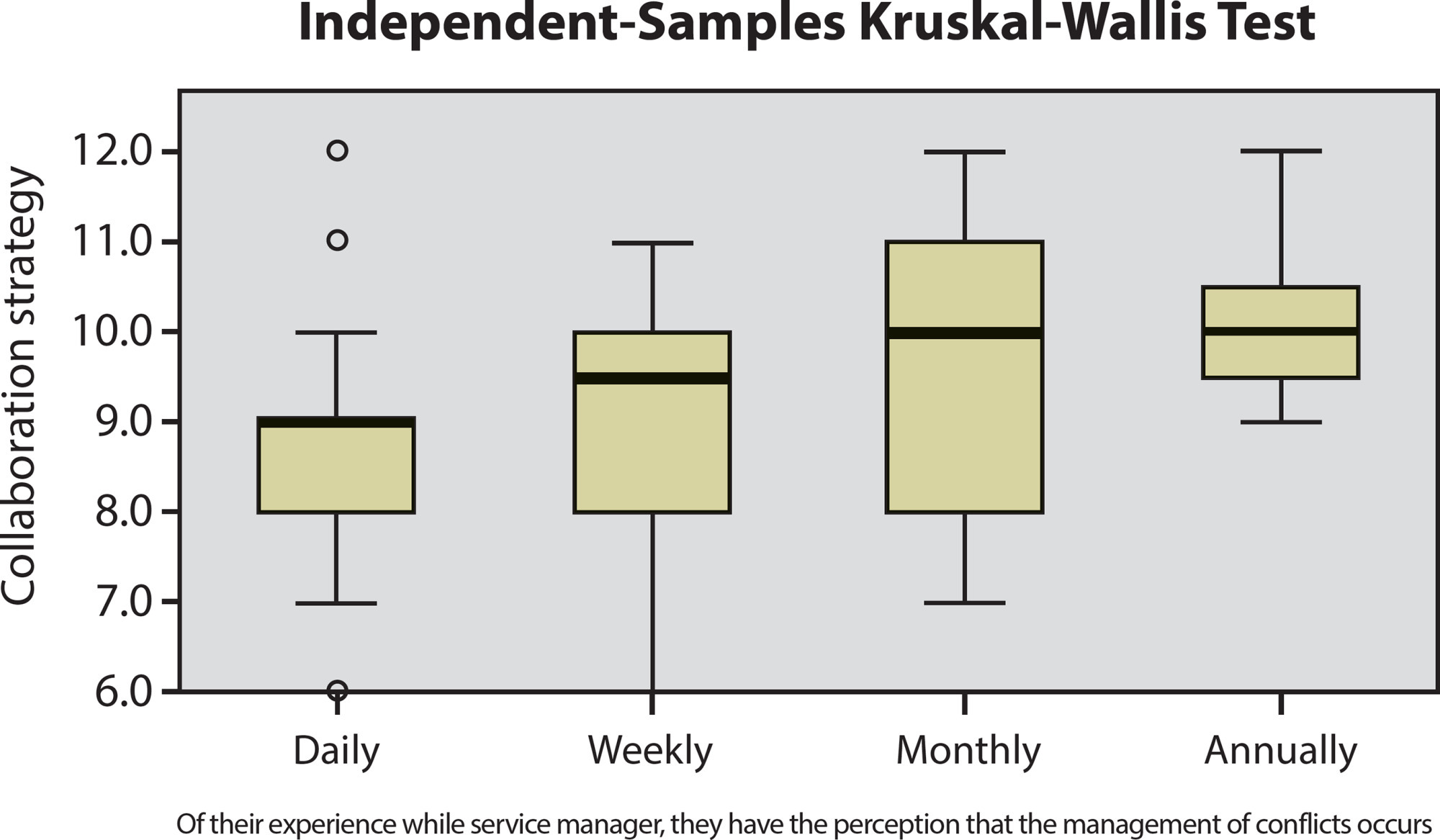
-
ORIGINAL ARTICLE10-01-2022
Frailty in the elderly: screening possibilities in Primary Health Care
Revista Brasileira de Enfermagem. 2022;75(2):e20200973
Abstract
ORIGINAL ARTICLEFrailty in the elderly: screening possibilities in Primary Health Care
Revista Brasileira de Enfermagem. 2022;75(2):e20200973
DOI 10.1590/0034-7167-2020-0973
Views0See moreABSTRACT
Objectives:
to evaluate two instruments for screening frailty in the elderly in Primary Health Care.
Methods:
this is an observational, cross-sectional study, with a quantitative approach, with 396 elderly people. SPSS software helped to perform the statistical analyses. The study used the kappa coefficient and Spearman’s correlation.
Results:
the kappa coefficient between the Clinical-Functional Vulnerability Index 20 and the Edmonton Frailty Scale was 0.496, considered moderate. There was a positive and significant correlation (r = 0.77; p < 0.001) between the frailty conditions and the total score of the two instruments.
Conclusions:
when this article assessed fragility through the kappa coefficient, both instruments presented positive correlation and agreement. However, the identification of frailty was higher when it used the Edmonton Frailty Scale.
-
ORIGINAL ARTICLE09-16-2019
Knowledge of nursing student on the prevention of sexually transmitted infections
Revista Brasileira de Enfermagem. 2019;72(5):1145-1152
Abstract
ORIGINAL ARTICLEKnowledge of nursing student on the prevention of sexually transmitted infections
Revista Brasileira de Enfermagem. 2019;72(5):1145-1152
DOI 10.1590/0034-7167-2017-0801
Views0See moreABSTRACT
Objective:
To identify the knowledge and self-care actions taken by nursing undergraduate students of a Federal University of the South of Brazil, against Sexually Transmitted Infections.
Method:
Exploratory qualitative study, conducted 40 interviews with undergraduate students at the beginning and end of the course. The analysis was thematic, resulting in three categories.
Results:
Knowledge about the subject is a decisive factor for self-care, and the more knowledge, the greater the prevention. The dissemination of knowledge of students at the end of the course not only influences self-care but also health promotion in the social sphere.
Final considerations:
Knowledge is important in self-care and caring for others. The dissemination of knowledge becomes evident according to the complexity of the course. Stable relationships may interfere with the use or disuse of condoms in sexual relationships, a misnomer present in today’s society.
-
ORIGINAL ARTICLE03-30-2020
Meanings assigned by families about children’s chronic disease diagnosis
Revista Brasileira de Enfermagem. 2020;73(2):e20180742
Abstract
ORIGINAL ARTICLEMeanings assigned by families about children’s chronic disease diagnosis
Revista Brasileira de Enfermagem. 2020;73(2):e20180742
DOI 10.1590/0034-7167-2018-0742
Views0See moreABSTRACT
Objectives:
to understand the meanings assigned by family caregivers about children’s chronic disease diagnosis.
Methods:
qualitative study, which used as theoretical framework the Symbolic Interactionism, and methodological, the Grounded Theory. It was held in a pediatric unit in Southern Brazil, in 2016, through interviews submitted to open and axial analysis, with the participation of 20 family caregivers of hospitalized children.
Results:
relatives, interacting with the nursing/health staff, perceive children’s disease at birth. They are diagnosed with chronic disease by the physician and deny it. Subsequently, they accept and seek information on care.
Conclusions:
the results pointed out the stages that relatives experience by assigning meanings to about children’s chronic disease diagnosis. These meanings provide subsidies for nurses’ actions, which need to be aware of children’s and family’s needs in order to offer comprehensive and humanized care.
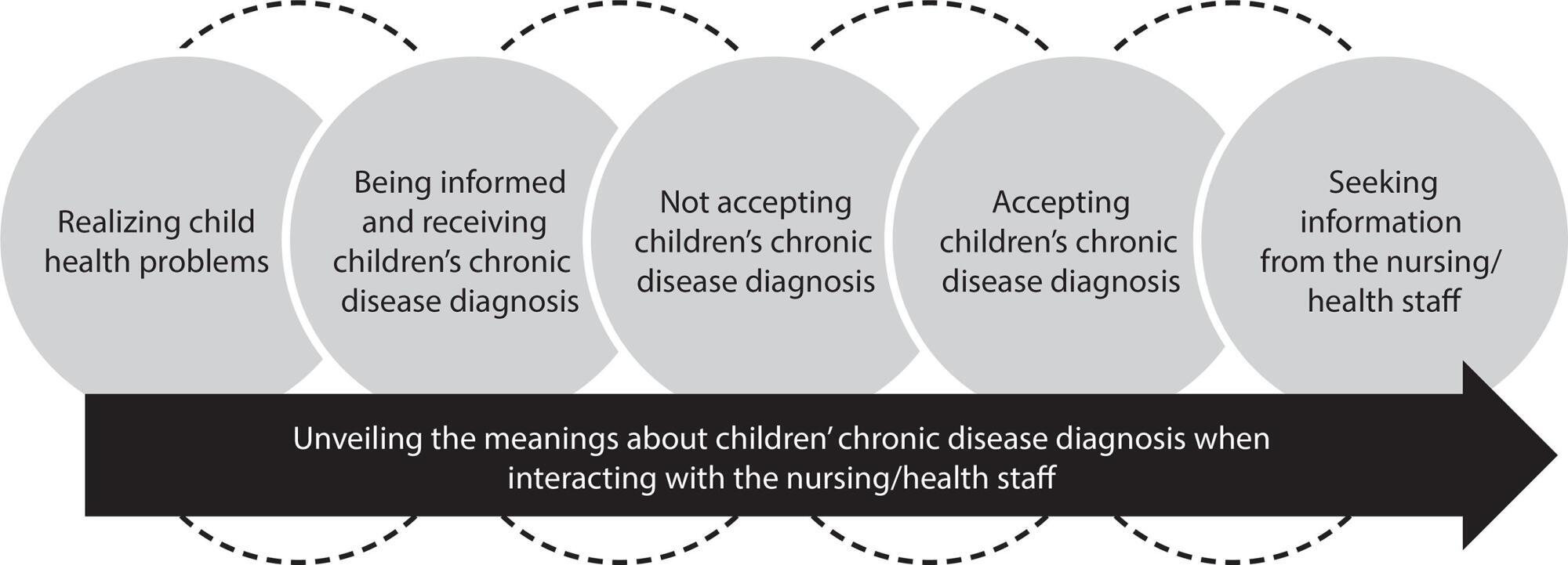
-
03-09-2020
Psychiatric nursing and mental health teaching in relation to Brazilian curriculum
Revista Brasileira de Enfermagem. 2020;73(2):e20180200
Abstract
Psychiatric nursing and mental health teaching in relation to Brazilian curriculum
Revista Brasileira de Enfermagem. 2020;73(2):e20180200
DOI 10.1590/0034-7167-2018-0200
Views0See moreABSTRACT
Objectives:
to know the scientific production on psychiatric nursing and mental health teaching in relation to Brazilian nursing curriculum.
Methods:
an Integrative Literature Review with no temporal delineation, whose data collection took place in ten Brazilian and international databases, adding to the total 35 objects of analysis.
Results:
a priori categories were adopted, consisting of the psychiatric nursing and mental health teaching in Brazil according to the 1923, 1949, 1962, 1972, 1994 and 2001 nursing curriculum, presented in the light of the dimensions: thought model; places of practice; methods or contents used; and profile or skills of the student.
Final considerations:
the study made it possible to observe psychiatric nursing and mental health teaching historical evolution, indicating that teaching transformations involved changes in curriculum, Psychiatric Reform and the way nursing undergraduate courses and schools take these determinants.
-
08-19-2019
Professional education on dementias in Primary Health Care: an integrative review
Revista Brasileira de Enfermagem. 2019;72(4):1086-1093
Abstract
Professional education on dementias in Primary Health Care: an integrative review
Revista Brasileira de Enfermagem. 2019;72(4):1086-1093
DOI 10.1590/0034-7167-2018-0652
Views0See moreABSTRACT
Objective:
To investigate the most commonly used educational approaches in dementia training for primary health care professionals.
Method:
Integrative literature review, conducted between April and June of 2018, in PubMed, LILACS and IBECS databases. The descriptors used were: Training, Health Personnel, Dementia, Primary Health Care for PubMed; and the MeSH terms, Training Programs, Health Personnel, Dementia, and Primary Health Care for LILACS and IBECS.
Results:
The sample consisted of 13 articles; eight were published in the last five years (62%); seven articles with a quantitative approach (54%); seven articles produced on the European continent (54%), followed by five published on the North American continent (38%). All journals were from the health area (100%).
Conclusion:
Educational strategies were combined and used for education. Significant improvements in knowledge, skills, and attitudes of the teams with regard to professional management of dementias were evidenced.
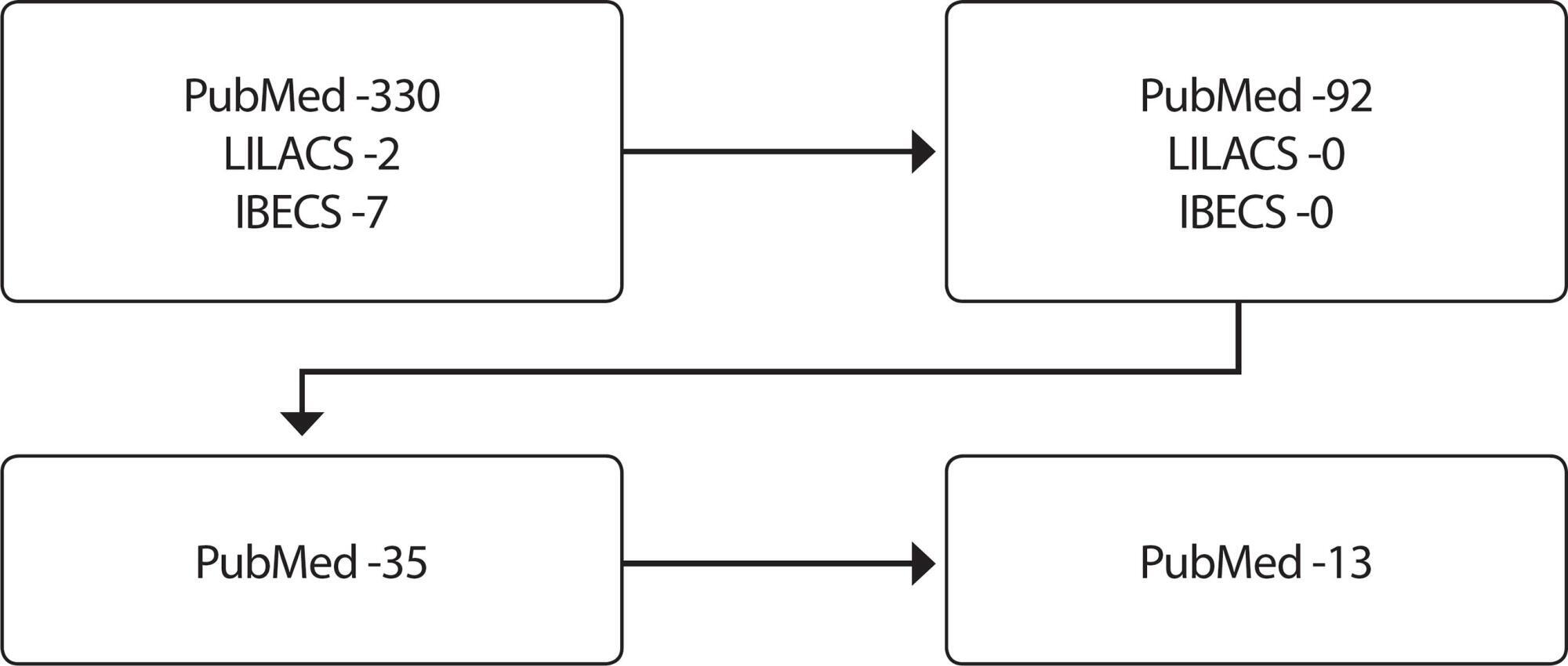
-
05-21-2021
Quality of life and falls in elderly people: a mixed methods study
Revista Brasileira de Enfermagem. 2021;74:e20200400
Abstract
Quality of life and falls in elderly people: a mixed methods study
Revista Brasileira de Enfermagem. 2021;74:e20200400
DOI 10.1590/0034-7167-2020-0400
Views0See moreABSTRACT
Objective:
to assess elderly people’s quality of life, understanding the social representations of falls.
Methods:
a convergent mixed methods research carried out at homes, with a sample of 134 elderly people. A structured questionnaire was used, covering sociodemographic variables and factors that indicated frailty and risk of falling. For quality of life assessment, Medical Outcomes Study Short-Form 36 and Theory of Social Representations, Abric’s structural approach were used, with data treated by dictionary of equivalent terms, processed in Evoc 2000, converging analytically according to Neuman.
Results:
quality of life impairment was identified in terms of physical, emotional and functional capacity. The elements of the possible central nucleus were fall, fear, and bruised-broken-bone.
Final considerations:
quality of life impairment can contribute to increase the number of falls, which has been shown to be an event present in elderly people’s lives through evocations. Understanding elderly people’s individual demands allows planning actions.
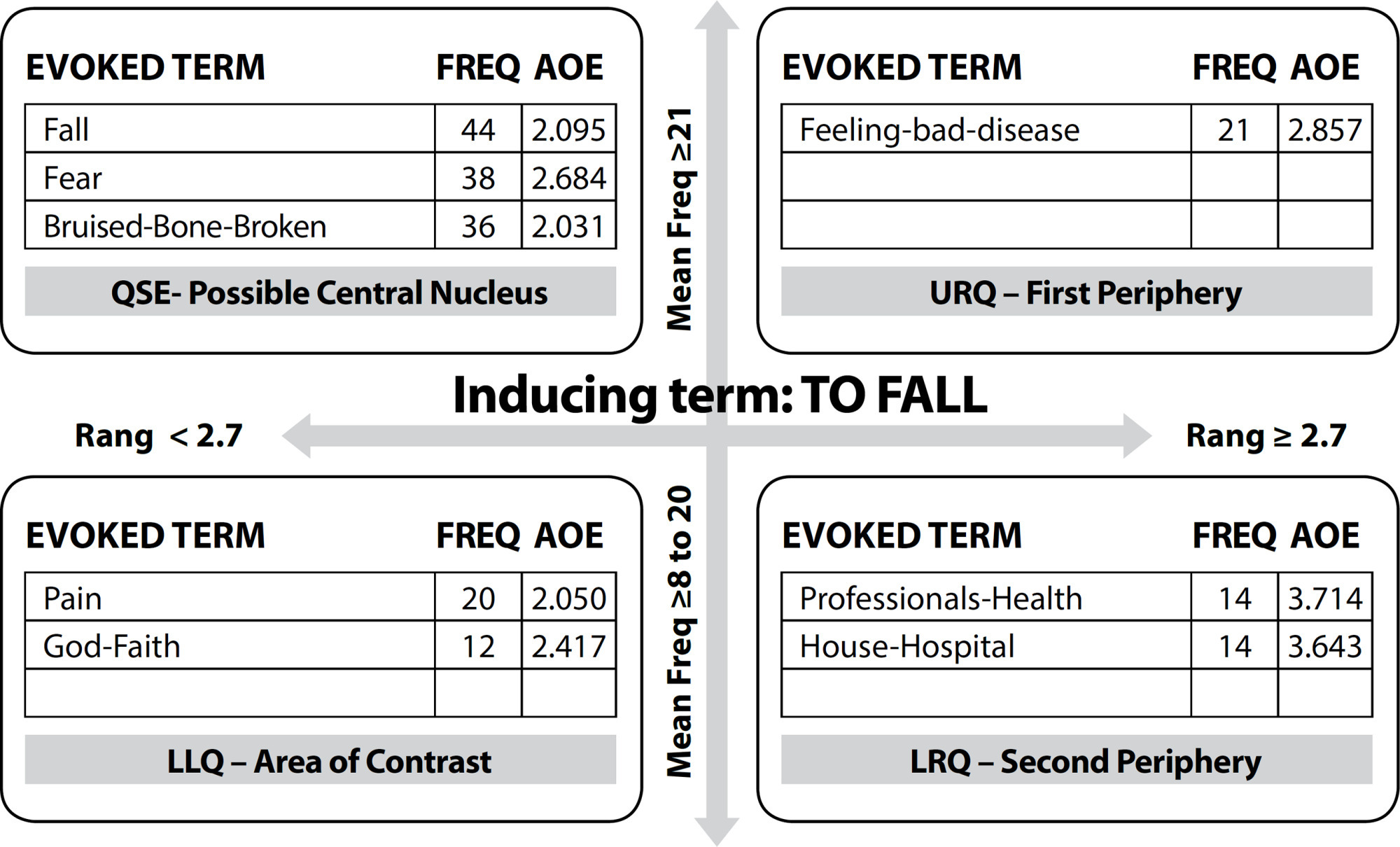
-
ORIGINAL ARTICLE07-08-2020
Patient safety: perception of family members of hospitalized children
Revista Brasileira de Enfermagem. 2020;73(5):e20190525
Abstract
ORIGINAL ARTICLEPatient safety: perception of family members of hospitalized children
Revista Brasileira de Enfermagem. 2020;73(5):e20190525
DOI 10.1590/0034-7167-2019-0525
Views0See moreABSTRACT
Objectives:
to know the meaning attributed by family members to the health safety of pediatric patients, with attention to the possibilities of their collaboration.
Methods:
this qualitative study was conducted with eighteen family members of children hospitalized in a pediatric unit, from January to July 2018. Symbolic Interactionism was used as a theoretical framework, and Inductive Content Analysis as method.
Results:
child hospitalization poses risks to possible incidents and adverse events. Participants and professionals are responsible for patient safety. Thus, their actions focus on error prevention. Therefore, they seek information and observe in a vigil way professional care in classic aspects of safety. They conceive essential and favoring safety the approach centered on children and family members.
Final Considerations:
family members recognized the chances of errors and care damage, identified themselves as support in minimizing damage and were in partnership with the professional, increasing chances of effecting safety.
Search
Search in:
Nuvem de Tags
Adolescente (85) Atenção Primária à Saúde (239) COVID-19 (91) Criança (91) Cuidados de Enfermagem (269) Educação em Enfermagem (151) Educação em Saúde (139) Enfermagem (930) Enfermagem Pediátrica (86) Estudantes de Enfermagem (77) Estudos de Validação (131) Família (87) Idoso (208) Promoção da Saúde (99) Qualidade de Vida (104) Saúde do Trabalhador (86) Saúde Mental (145) Saúde Pública (82) Segurança do Paciente (150) Tecnologia Educacional (100)



